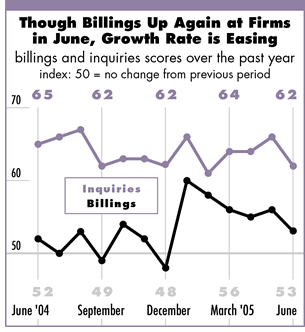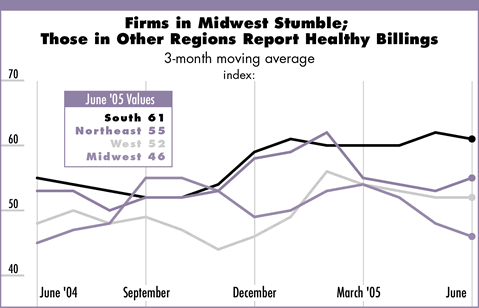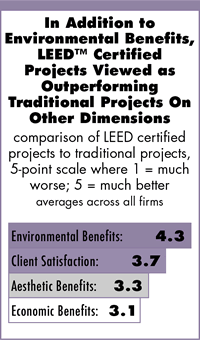

08/2005
Firms see mostly increased benefits from sustainable architecture
by Kermit Baker, PhD, Hon. AIA
 U.S.
architecture firms reported growth in billings in June, but the pace
of growth has slowed substantially since the beginning of the year. In
June, almost 23 percent of firms reported that billings had increased
compared to May levels, but 14 percent of firms reported that they declined
over this period. According to analysis conducted by the AIA, the strong
growth in billings reported by firms points to an upturn in construction
levels later this year, while the recent easing in growth in billings
at firms points to slower growth in construction activity during the
first half of 2006. (See the related explanation of the new AIA Architectural
Billings Index, right.)
U.S.
architecture firms reported growth in billings in June, but the pace
of growth has slowed substantially since the beginning of the year. In
June, almost 23 percent of firms reported that billings had increased
compared to May levels, but 14 percent of firms reported that they declined
over this period. According to analysis conducted by the AIA, the strong
growth in billings reported by firms points to an upturn in construction
levels later this year, while the recent easing in growth in billings
at firms points to slower growth in construction activity during the
first half of 2006. (See the related explanation of the new AIA Architectural
Billings Index, right.)
Though the growth in billings has been easing as the year has progressed, inquiries for new work have remained strong. Although the level of inquiries remained strong in June, the pace of growth has eased a bit from levels seen in recent months. However, the trend in inquiries activities points to continued solid growth in billings activity over the next several months.
Regionally, firms in the South reported strong growth in billings in June, while firms in the Northeast and West reported modest increases. Firms in the Midwest reported a decline in June. Firms specializing in the residential sector reported a strong increase in billings in June, while those firms concentrating in the commercial and institutional sectors reported modest increases.

Broader economy grows slowly
The broader U.S. economy continues to move ahead very slowly. Just fewer
than 150,000 new payroll jobs were added in June, bringing the second
quarter total to 540,000, about the same number as were added in the
first quarter of the year. The construction sector remains one of the
bright lights in the employment picture, adding 150,000 jobs over the
first six months of the year.
The housing market shows no signs of slowing. The more than two million homes started in June (seasonally adjusted and annualized) mark the third month in a row and the fifth of the past six that housing starts have been over the two million level.
Despite a healthy economy, higher fuel costs and international uncertainty have taken their toll on confidence levels. The consumer sentiment index from the University of Michigan was essentially flat from the preliminary July reading, after having dipped in five of the first six months of the year. Business confidence has fared even worse, with the second quarter 2005 reading at its lowest level since early 2003.
 LEED™-certified projects’ performance
rates high
LEED™-certified projects’ performance
rates high
Interest in the principles of sustainable design has been increasing
in recent years. Just over a quarter of our AIA Work-on-the-Boards
panel reports that they are actively involved in projects seeking LEED™ (Leadership
in Energy and Environmental Design) certification, and another 16 percent
report that they are peripherally involved. We asked those firms to
rate the performance of LEED-certified projects as compared to traditional
projects along four dimensions.
To no surprise, environmental benefits (e.g. energy use, use of renewable resources) is the dimension where respondents feel that LEED-certified projects perform the best as compared to traditional buildings. Well over 90 percent of respondents feel that LEED projects perform better in terms of environmental benefits; fewer than 2 percent feel that they perform worse. On a five-point scale, with 5 corresponding to “much better” than traditional buildings, and 1 to “much worse,” our panel rated LEED projects as 4.3 on average for environmental benefits.
Along other dimensions, the perceived benefits of LEED projects were more mixed. Almost two-thirds of our panel felt that LEED projects generated higher client satisfaction, while only 6 percent felt that they generated lower client satisfaction. Just over a quarter of respondents felt that that the aesthetic benefits (e.g. design appeal, appearance) of LEED projects exceeded those of traditional buildings; 7.5 percent felt that were worse. Most respondents (66 percent) felt that there was no difference between LEED and traditional projects on this dimension.
In terms of economic benefits (e.g. construction costs, operating costs, ease of rehabilitation), just about an equal share felt that LEED-certified projects performed better than traditional buildings (38.8 percent) as felt that they performed worse (37.3 percent). The remaining 24 percent felt that there was no difference along this dimension.
Copyright 2005 The American Institute of Architects.
All rights reserved. Home Page ![]()
![]()
